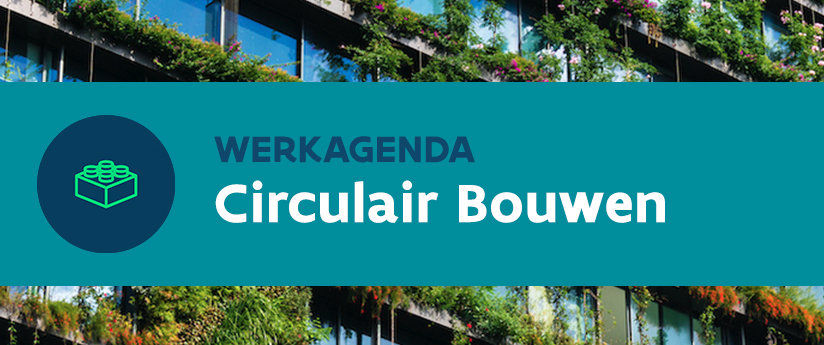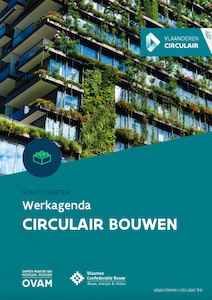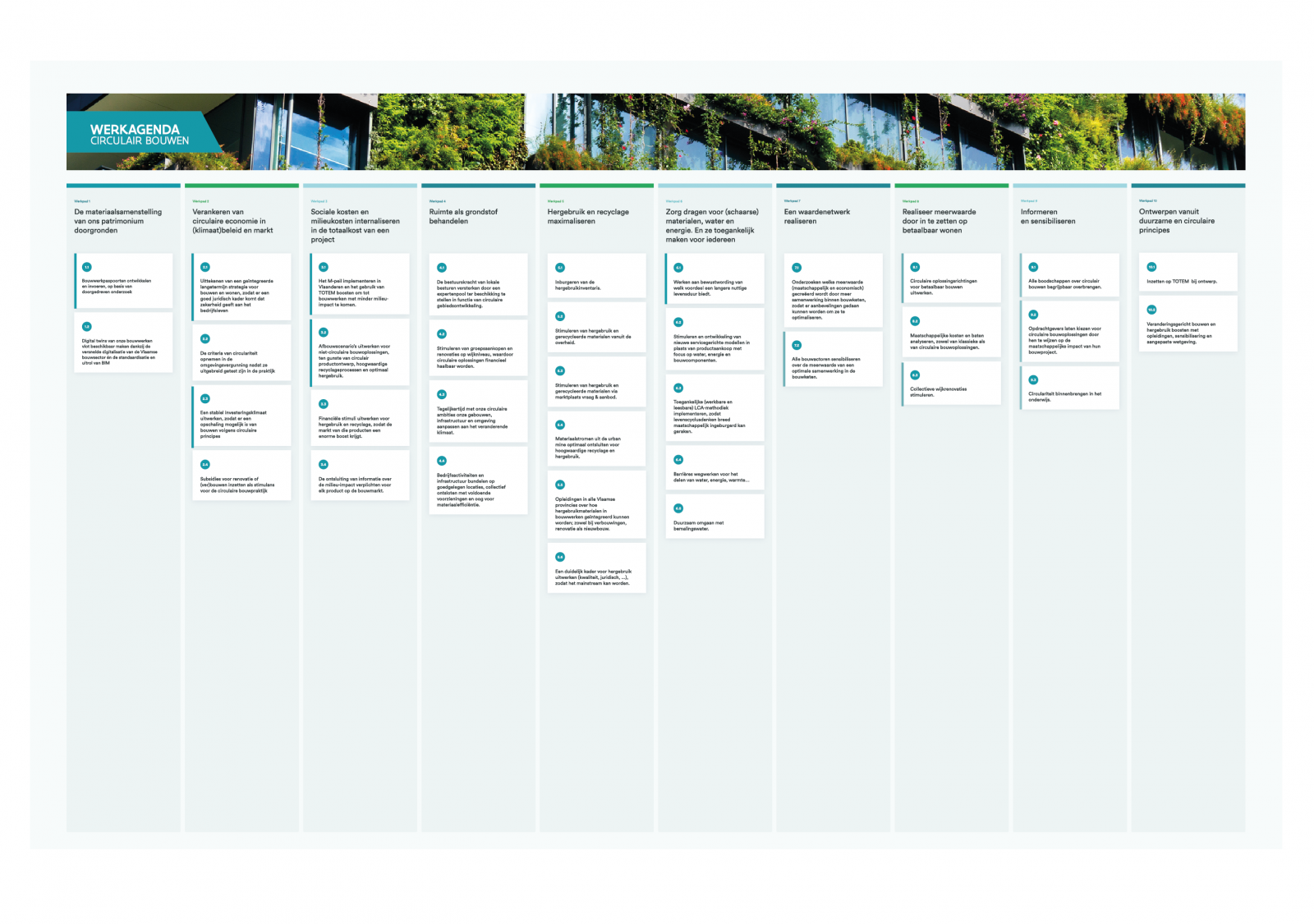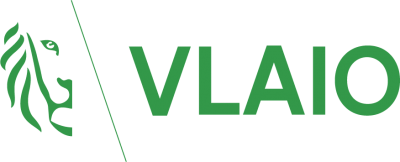Topics
We organise our actions in six thematic & strategic agendas:
Strategic Agendas:
Bio-economy
Circular Construction
Chemicals/Plastics
Manufacturing Industry
Food Chain
Water Cycles
Seven leverages provide additional support:
Leverage effects:
Lever Policy Instruments
Lever Circular Procurement
Lever Communication
Lever Innovation & Entrepreneurship
Lever Financing
Lever Jobs & Skills
Lever Research
What, why and how?
Why are we pursuing a circular economy?
Future visions 2050
How do we see our circular future?
About our management
Who steers what at Flanders Circular?

Our Approach / Strategic Agendas
Circular Construction

Work paths and actions
The Circular Construction Strategic Agenda is conceived as a rolling action programme. Together with all committed stakeholders, we selected about 40 (sub)actions that are important catalysts for other actions and through which we want to achieve visible results in 2023-2024.
Presentation of the strategic agenda
In our strategic agenda report you will find all actions and commitments in detail.
Our 10 working paths summarised
1. Understanding the material composition of our assets
To facilitate reuse and recycling of materials in construction, we need to know what materials are currently contained in the built heritage. This insight is largely lacking today. In Workpath 1, we develop an Open Standard for a building passport in which these data can be included. At the same time, we exploit the opportunities of digitisation in the Flemish construction sector. By working out a BIM standard and creating a clear agreement framework, we ensure that information exchange between the parties involved in the chain is strengthened.
| (Focus actions 2023 - 2024) | Results we aim for |
|---|---|
| Develop and implement construction passports, based on thorough research | |
| Mapping and analysing projects around development of construction passports | The learning lessons about what does/doesn't work have been researched. So we know what should be included in a construction work passport. |
| Develop an open standard construction passport | An open standard construction work passport has been developed based on experience in actual projects. An important requirement is that the construction work passport must remain accessible over time (=universally readable and retrievable). |
| Making digital twins of our constructions readily available thanks to the accelerated digitisation of the Flemish construction sector and the standardisation and roll-out of BIM | |
| BIM standard roll out | Thanks to the roll-out of a Building Information Management (BIM) standard, construction and management processes in Flanders are more efficient and information exchange between the parties involved is strengthened. We arrive at an agreement framework around data exchange to realise circular construction projects. |
| Making manufacturers' product information available through BIM-based applications | Builders, architects and buyers can easily access product information (material type, environmental impact, origin, technical specifications,...) through open source BIM-based applications. The information helps them make decisions. When providing product information, the CBI (Confidential Business Information) is of course taken into account. |
2. Embedding circular economy in (climate) policy and market
Both business leaders and policymakers are not yet sufficiently aware of the role circular building can play as a means for climate adaptation/mitigation as well as increased prosperity and well-being. We want business leaders and politicians to proactively invest in circular solutions. Therefore, in work path 2, we explore what CEOs and policymakers need to fully address climate and circular economy ambitions. We will also explore how the European Taxonomy Regulation can be leveraged for the necessary investments in circular construction.
| (Focus actions 2023 - 2024) | Results we aim for |
|---|---|
| Outlining an integrated long-term strategy for building and housing, ensuring a proper legal framework that gives certainty to the business community | |
| CEO round table discussions | Through an exploratory exercise with some tone-and-directional CEOs, it becomes clear(er) what Flemish companies need to fully address climate and circular economy ambitions. |
| Work out a stable investment climate to allow scaling up of building according to circular principles | |
|
Explore European legislation as a linkage opportunity:
|
Research provides insight into the extent to which Taxonomy Regulation can be leveraged for investments in circular building. Thanks to the revision of the European regulation on the energy performance of buildings, structural inclusion of the material footprint has been accelerated. This puts fully-fledged climate-positive (renovation) building solutions on the map. The adaptability of the building heritage is also taken into account in the energy performance. |
3. Internalise social and environmental costs in the total cost of a project
Today, we mainly consider the financial picture when making important decisions on building and renovation. In work path 3, we are developing tools that map the environmental impact of building and renovation in addition to the financial picture. TOTEM, as a tool for measuring the material impact of buildings, is being developed further. And we are putting the introduction of an M-level, similar to the E-level, on the political agenda.
| (Focus actions 2023 - 2024) | Results we aim for |
|---|---|
| Implement the M-level in Flanders and boost the use of TOTEM to achieve constructions with less environmental impact | |
| Conduct research on M-level implementation abroad (continuous action) | We know how the M-level works elsewhere. The approach in the Netherlands for buildings and infrastructure, among others, was looked at. |
| Extending TOTEM to infrastructure | |
| Putting TOTEM and M-level on the agenda | The need for M-level implementation has been put on the agenda and validated. Both among politicians, policymakers federations and companies. |
| Calculating the M-level of structures (without benchmark, as an experiment) | Construction works with planning permission are required to make a calculation of the M-level. This collects valuable data on the order of magnitude of an M-level for different building types. |
| Expanding the TOTEM training offer | All stakeholders have access to robust, tailor-made TOTEM training so that they can easily use the tool to objectify and reduce the environmental impact of construction works |
| Devising demolition scenarios for non-circular construction solutions, in favour of circular product design, high-quality recycling processes and optimal reuse | |
| Investigate what the interfering substances are for recycling and reuse | Sorting centres and material manufacturers know perfectly well which material combinations prevent high-quality recycling and/or reuse. |
4. Treating space as a resource
Circular construction is more than efficient use of materials. In work path 4, we also want to donate to the efficient use of space. This is how we achieve 'circular area development'. We support local governments to be stronger in this and focus on efficient use of space, quality of space including greening, liveability and accessibility.
| (Focus actions 2023 - 2024) | Results we aim for |
|---|---|
| Strengthening the administrative capacity of local governments by making an expert pool available in function of circular area development | |
| Greening the city | The city's green-blue network has been strengthened, with ample opportunities for short-chain agriculture |
| Explore needs / requirements of businesses in terms of space | Transform existing business parks by combining more spatial efficiency with more quality (architectural/green-blue/livability) and multimodal, traffic-safe access. |
| Bringing circularity into collective renovation processes | Demonstrate opportunities for circularity in collective renovation projects (technical, financial, legal, etc.) |
5. Maximising reuse and recycling
In general terms, the construction sector already scores very well when it comes to recycling materials. In particular, the large volume of stony materials is already largely recycled. Yet we can still make strides in recycling by using recycled materials in higher-value applications and by increasing recycling of non-stony materials. And reuse is also on the rise. In work path 5 we want to implement actions that stimulate reuse and high-grade recycling even further: from developing a framework (quality, legal, etc.) for reuse and recycling to introducing a reuse inventory.
| (Focus actions 2023 - 2024) | Results we aim for |
|---|---|
| Embedding the reuse inventory | |
| Optimising material flows from urban mine for high-quality recycling and reuse | |
| Bringing manufacturers' information on acceptance criteria together on one platform | Because all acceptance criteria are on one platform, it is easier for scrappers and dismantlers to identify their costs and benefits and to make targeted efforts to make material streams available for high-quality recycling. They also know the various locations from which material streams are transported to manufacturers in bulk. |
| Development of Demolition Management organism 2.0 for releasing info on the urban mine, and potential reuse more in-depth reporting as a function of urban metabolism | Data analysis on demolition inventories has produced a barometer that provides insight and communicates which material streams will be released when. Building material producers who take on extended producer responsibility can put their business model for recycling streams on this. |
| Develop a clear framework for reuse (quality, legal, etc.) so that it can become mainstream | |
| Inventory of know-how | We want to understand the know-how and modus operandi in current demolition and decommissioning practices. |
| Analyse whether reuse materials can be tested using the same tests and standards | Thanks to the analysis, we know which material types are smoothly eligible for reuse. We also have insight into the application- and context-specific considerations that need to be made. If new test methods or procedures are needed, they are developed. |
| Testing and developing procedures | A blueprint of script defines the necessary test systems and procedures (e.g. with regard to uniformity in sampling, specific analyses and the distinction between must-haves and nice-to-haves) |
6. Taking care of (scarce) materials, water and energy. And making them accessible to all
We also pay attention in the Circular Construction Agenda to the efficient use and care of (scarce) materials, energy and water: e.g. by making sure they have a long lifespan, by ensuring that water, energy and heat can be shared, by dealing sustainably with drainage water. In work path 6, we focus on this.Voorlopig worden er geen focusacties weerhouden binnen dit werkpad. Dit wil niet zeggen dat de acties die erin opgenomen waren, niet zullen of kunnen worden uitgevoerd. Sommige acties kaderen immers ook binnen andere programma’s.
7. Realising a value network
To achieve a circular construction sector, cooperation in the value chain is key. The construction chain as we know it today is fragmented; little knowledge is shared. New roles are needed (coordination/director function), new forms of cooperation can support circular construction. In work path 7, we investigate and experiment with new cooperation models to manage materials, building products and structures more effi ciently.
| (Focus actions 2023 - 2024) | Results we aim for |
|---|---|
| Investigate the added value (social and economic) created by more cooperation within construction chains, so that recommendations can be made to optimise them | |
| Explore need for new coordinator/director position in construction | Experiments were realised in which a new director function was tested and it was clarified who takes what responsibility within a construction project. Funding was also found that enabled cooperation between chain partners. |
8. Realise added value by focusing on affordable housing
Circular (re)construction techniques are only successful if they are also affordable. In work path 8, we explore how circular principles contribute to affordable housing: alternative ownership models (e.g. cooperatives or service models) or new financing models are investigated and tested. In addition, we also engage in public tenders to encourage circular solutions and take actions around collective neighbourhood renovations as a means to control affordability.
| (Focus actions 2023 - 2024) | Results we aim for |
|---|---|
| Developing circular solution directions for affordable construction | |
| Explore support options (fiscal, subsidies, etc.) for alternative ownership (e.g. cooperatives, as-a-service models, etc.) | Thanks to research on supporting alternative ownership models and by involving traditional financial institutions in this exercise, (circular) building is becoming more affordable. |
| Exploring and encouraging alternative funding models | We have mapped whether/to what extent alternative financing models offer social and environmental added value, and make housing more affordable. These financing models also enable long-term financing |
| Analyse social costs and benefits of both conventional and circular building solutions | |
| Using public procurement and award procedures to encourage circular solutions | Public tenders are assessed with equal regard to financial and broad social benefits, both for buildings and infrastructure. |
| Encouraging collective neighbourhood renovations | |
9. Informing and raising awareness
Circular construction is still relatively new. It also involves many different aspects. Via work path 9, we focus on an understandable message and inspiring stories to inform all building actors and clients about circular construction and its advantages and disadvantages. At the same time, we take action to bring circularity into education and training, so that all construction professionals develop sufficient knowledge and competences for the circular construction sector of the future.
| (Focus actions 2023 - 2024) | Results we aim for |
|---|---|
| Conveying all messages about circular construction in an understandable way | |
| Getting clients to opt for circular construction solutions by educating them on the social impact of their construction project | |
| Communicating the benefits of circular (re)construction through inspiring stories | By bringing inspiring stories to the press, all the benefits of circular (re)construction are brought into focus for clients and also private building owners. Thanks to examples at major building owners such as governments and retailers, theoretical arguments are replaced by practical experience. They get concrete insight into the financial and environmental benefits. |
| Bringing circularity into education/training | |
10. Designing from sustainable and circular principles
To accelerate the circular transition in the building sector, circular principles must be assumed from the building design stage onwards. In work path 10, we focus on tools that assess how circular the design is. Through training and awareness-raising, we boost change-oriented construction, where buildings are designed with future functions in mind.
| Possible (sub)actions | Results we aim for |
|---|---|
| Commit to TOTEM by design | |
| Educating designers about TOTEM and integrating the tool into their day-to-day operations | Because TOTEM is integrated into all public contracts and there is a structural supply of TOTEM training courses, designers in Flanders are familiar with this tool to calculate the environmental impact of their design. They readily apply this tool and provide insight and substantiation to their clients regarding material choices. |
| Expanding TOTEM on circularity | Expansion of the MMG methodology with circular construction solutions via integration of, among others, use scenarios and calculation of environmental gains through (repeated) reuse and (closed-loop and open-loop) recycling in-situ + integration of new functionalities in the TOTEM tool |
| Boost change-oriented construction and reuse with training, awareness-raising and adapted legislation | |
| Mainstreaming and embedding circular principles among designers | Circular building strategies are a structural part of the curriculum in all construction-related educational institutions and graduate courses for designers. Design assignments also consider temporary use of vacant patrimony. |
| Removal of obstacle regarding liabilities and responsibilities | The legal framework around reuse is clear and legal barriers for designers have been removed. Procedures on reuse are also clearly defined. |
Develop and implement building passports, based on thorough research
Making digital twins of our constructions readily available thanks to the accelerated digitisation of the Flemish construction sector and the standardisation and roll-out of BIM
Outline an integrated long-term strategy for building and housing, in order to create a legal framework, providing security to the business community
Incorporate circularity criteria in the environmental permit based on extensive testing in practice
Work out a stable investment climate to allow upscaling of construction according to circular principles
Using subsidies for renovation or (re)construction as an incentive for circular building practices
Implement a Material-level in Flanders and boost the use of TOTEM (Tool to optimize the environmental impact of materials) to reduce the environmental impact of constructions.
Develop demolition scenarios for non-circular building practice, in favour of circular product design, high-quality recycling processes and optimal reuse.
Design/develop financial incentives for reuse and recycling, to boost the market for circular materials.
Mandatory disclose information on the environmental impact of each product on the construction market
Strengthen the administrative capacity of local governments by providing an expert pool for circular area development.
Encourage group purchases and renovations at district level, making circular solutions financially viable.
Adapt our buildings, infrastructure and environment to the changing climate, while realizing our circular ambitons.
Pool business activities and infrastructure in well-located locations, collectively accessed with adequate facilities and an eye for material efficiency.
Embed the reuse inventory.
Encourage reuse and use of recycled materials, by the government.
Encourage reuse and use of recycled materials through supply & demand marketplace.
Optimise material flows from the urban mine for high-quality recycling and reuse.
Organise training all over Flanders on the reuse of materials in construction works, as well as for conversions, renovations and new buildings.
Develop a clear framework for recycling and reuse (quality, legal, etc.) for it to become mainstream.
Raise awareness for the benefits of life time extention.
Encourage and develop new service-oriented models rather than product procurement with a focus on water, energy and building components.
Implement accessible (workable and readable) LCA methodology so that life-cycle thinking will become widely adopted in society.
Break down barriers for sharing water, energy, heat...
Sustainable handling of drainage water.
Document the added value (social and economic) of circular cooperation models, to optimize practice and to lead the way for recommendations.
Raise awareness among all construction actors about the added value of optimal cooperation in the construction chain.
Develop circular solution approaches for affordable construction.
Analyse social costs and benefits of both conventional and circular building solutions.
Encourage collective neighbourhood renovations.
Communicate about circular construction in an understandable way.
Inform future builders about the societal impact of their construction project, in order for them to opt for circular building solutions.
Introduce circularity in training and education.
Use TOTEM from the design stage .
Stimulate change-oriented construction and reuse in training, awareness-raising and appropriate legislation.


















